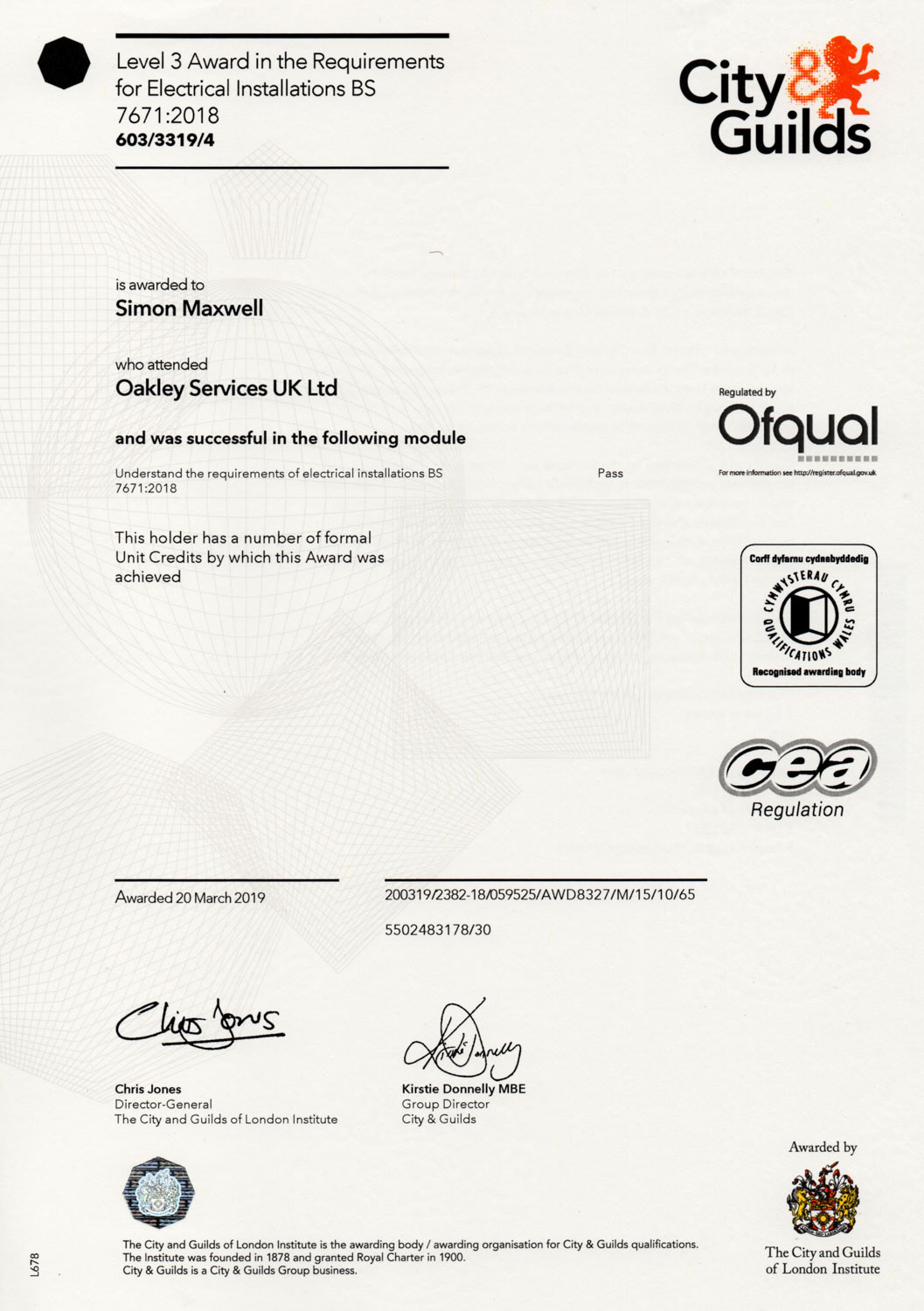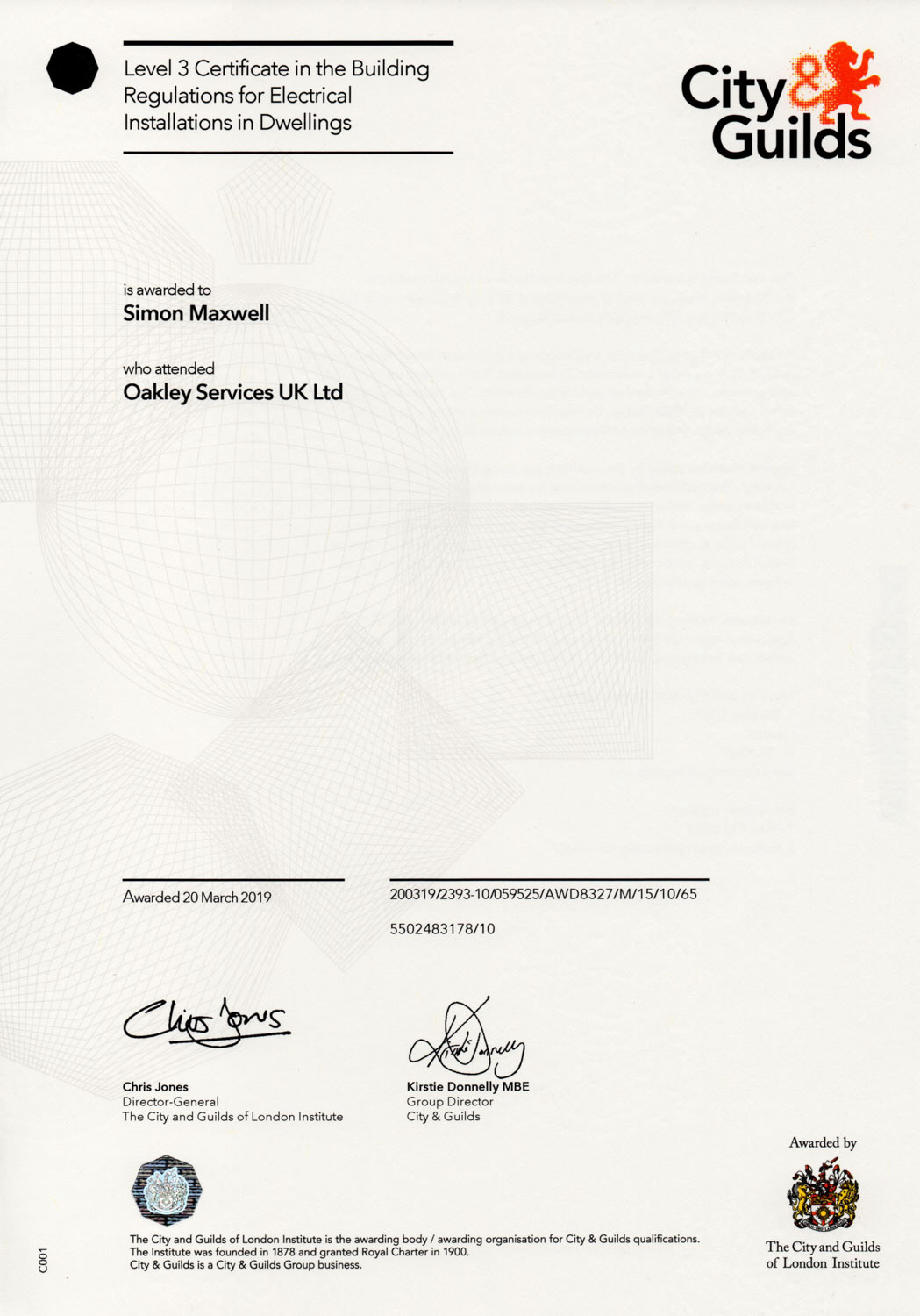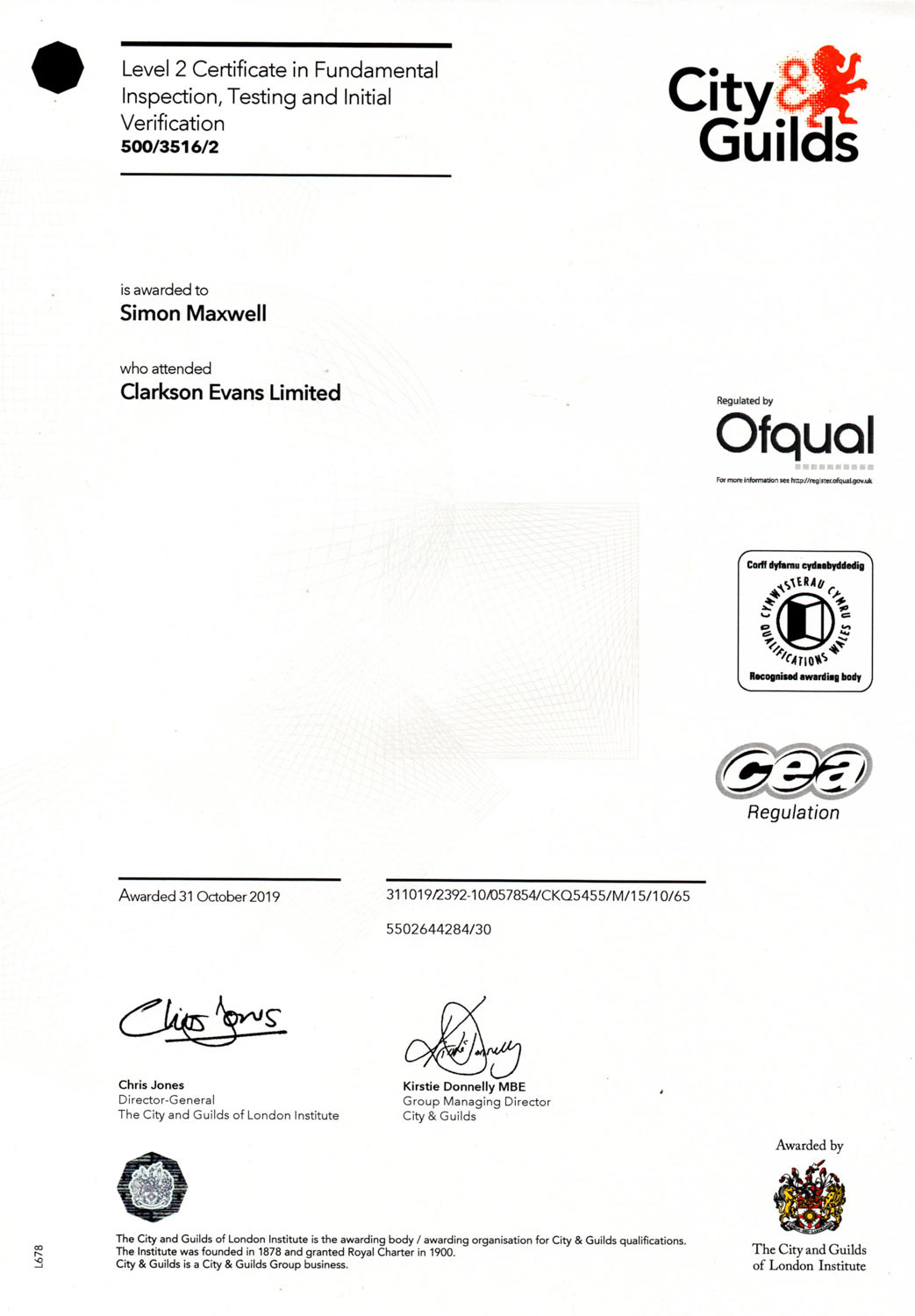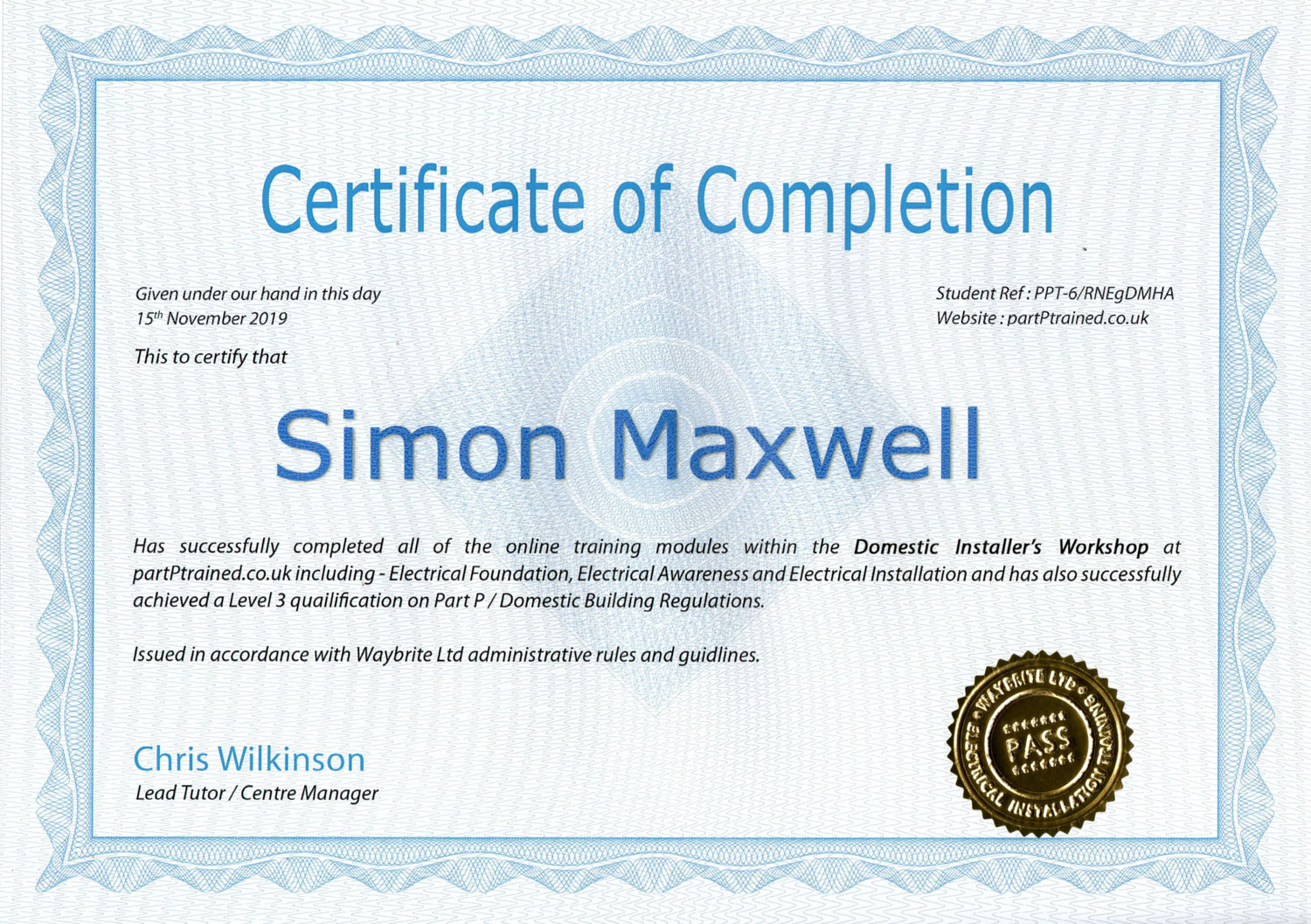Please read this before contacting me regarding any sort of electrical work:
I am not yet a fully registered electrician, and nor am I yet a registered member of one of the Competent Persons Schemes (CPS) with NICEIC, NAPIT or ELECSA.
What does this mean in practice? It means I am only legally allowed to undertake very limited or "minor" electrical work; such work is classed as "non-notifiable" as it does not require sign-off by building control. Work such as replacement or relocation of sockets and lighting points on existing circuits only qualifies as "non-notifiable" work. Any work which involves the creation of a new circuit, and also work in some specific areas such as bathrooms, is classed as notifiable.
I will not undertake such work until I am a member of a CPS (whose members are able to self-certify notifiable work).
For full information about what constitutes Minor Electrical Work please visit this page>>>
IMPORTANT STATEMENT
I am not yet a fully registered electrician, and nor am I yet a registered member of one of the Competent Persons Schemes (CPS) with NICEIC, NAPIT or ELECSA.
What does this mean in practice? It means I am only legally allowed to undertake very limited or "minor" electrical work; such work is classed as "non-notifiable" as it does not require sign-off by building control. Work such as replacement or relocation of sockets and lighting points on existing circuits only qualifies as "non-notifiable" work. Any work which involves the creation of a new circuit, and also work in some specific areas such as bathrooms, is classed as notifiable.
I will not undertake such work until I am a member of a CPS (whose members are able to self-certify notifiable work).
For full information about what constitutes Minor Electrical Work please visit this page>>>
IMPORTANT STATEMENT
All minor electrical works which I might undertake are installed with reference to the current version of the Part P Building Regulations (BS7671 18th edition: Amendment 2) .
Works are fully tested with calibrated testing equipment and are issued with all applicable certification (Minor Electrical Installation Works Certificate : MEIWC)
Installations are carefully photographed at key stages and test results readouts are also photographed : clients are able to access a password-protected online image gallery with all photographs and duplicate certificate, available for free download and inspection at any time.
I take the safety of my customers and their property with the utmost seriousness. I am in the process of assembling a portfolio of completed minor works which may be submitted to supervisors, training organisations and CPS assessors in future.
Works are fully tested with calibrated testing equipment and are issued with all applicable certification (Minor Electrical Installation Works Certificate : MEIWC)
Installations are carefully photographed at key stages and test results readouts are also photographed : clients are able to access a password-protected online image gallery with all photographs and duplicate certificate, available for free download and inspection at any time.
I take the safety of my customers and their property with the utmost seriousness. I am in the process of assembling a portfolio of completed minor works which may be submitted to supervisors, training organisations and CPS assessors in future.
Customers can be assured of my professionalism, safety-consciousness, respect for property and courtesy.
Why I have bothered to get qualified in order to carry out minor works?
It should be noted that there is no obligation for an electrician to hold any qualifications in order to carry out minor or "non-notifiable"works. The regulations simply state that those working on installations be competent and sufficiently skilled to ensure that their work is compliant. My own feeling is that can only be beneficial to obtain the usual industry-recognised electrical qualifications, and also to pursue some voluntary continuing professional development, as an electrician operating at any level. I have also invested in up to date, regs- compliant electrical testing equipment so that I can issue the required certification for the work I carry out.
It should be noted that there is no obligation for an electrician to hold any qualifications in order to carry out minor or "non-notifiable"works. The regulations simply state that those working on installations be competent and sufficiently skilled to ensure that their work is compliant. My own feeling is that can only be beneficial to obtain the usual industry-recognised electrical qualifications, and also to pursue some voluntary continuing professional development, as an electrician operating at any level. I have also invested in up to date, regs- compliant electrical testing equipment so that I can issue the required certification for the work I carry out.
In the course of renovating my own home over the last five years, I have continually run in to the need to work with the existing electrical installation: moving and adding sockets, changing light fittings, repairing damaged cables etc. My view is that many handyman tasks, such as putting up shelves and other fixtures, or even stripping and painting a room, often requires interaction with and sometimes adjustment of electrical fixtures and wiring. I therefore decided three years ago to develop my knowledge of domestic electrical systems and regulations and get sufficiently qualified in order to be able to carry out minor, non-notifiable works only to a professional standard for other householders.
I continue to keep abreast of developments in the electrical industry and am currently developing a body of work with which to progress to the next level of qualification and eventual membership of a Competent Persons Scheme.
Remember that any electrical work carried out in your home needs to be properly certificated: without the proper expertise and testing equipment such certification cannot be issued, and may cause issues when it comes to selling your home or in the event of an insurance claim.
I continue to keep abreast of developments in the electrical industry and am currently developing a body of work with which to progress to the next level of qualification and eventual membership of a Competent Persons Scheme.
Remember that any electrical work carried out in your home needs to be properly certificated: without the proper expertise and testing equipment such certification cannot be issued, and may cause issues when it comes to selling your home or in the event of an insurance claim.
Qualifications
In order to be as transparent as possible, here are the various industry-recognised training certificates that I currently hold:
City and Guilds Level 3 Award in the Requirements for Electrical Installations BS7671: 2018
City and Guilds Level 3 Certificate in the Building Regulations for Electrical Installations in Dwellings
City and Guilds Level 2 Certificate in Fundamental Inspection, Testing and Initial Verification, facilitated via in-house training provided by Clarkson Evans.
I also hold a certificate of completion for a Domestic Electrical Installers' course, provided by Waybrite Training Ltd
While this certificate is not an industry-recognised qualification in itself, I maintain that it was an extremely thorough and well-explained course, which enabled me to achieve the City and Guilds certificates in the Requirements for Electrical Installations and the Building Regulations for Electrical Installations in Dwellings, plus the theoretical component of the Level 2 Certificate in Fundamental Inspection, Testing and Initial Verification, as above.




Electrical work falls into two categories: what they call "notifiable" work, which must be approved by the local building control officer, and non-notifiable work which does not require sign off by building control. Both types of work, however, require full testing, inspection and distinct certification on completion.
Please note that I am currently only able to undertake non-notifiable work.
Examples of notifiable work*
Full rewire
Replacement consumer unit
Work which takes place within a special "zone"or location, such as a bathroom or wetroom/ sauna
Any new circuit (which would require the use of a slot or "way" in the consumer unit or a new mini consumer unit) : e.g. new feed to an outbuilding or a 7000W EV charging station
All such work must be accompanied by an EIC (Electrical Installation Certificate) plus a Building Control Certificate of Compliance. If the work is carried out by an electrician who is registered with one of the Competent Persons Schemes (CPS) , such as that provided by NICEIC or NAPIT, the Building Control Certificate of Compliance can be applied for by the electrician: what is known as self-certification. If a non-registered electrician or DIYer wishes to undertake notifiable work, they must inform Building Control in advance of the works and then pay a substantial fee for Building Control to come out perhaps more than once to inspect and test the works. Many councils now lack the resources to offer such inspections and the advice is generally to use an electrician who is registered with one of the schemes; they can self-certify the work, and save the customer having to pay building control fees.
Please note that I am currently only able to undertake non-notifiable work.
Examples of notifiable work*
Full rewire
Replacement consumer unit
Work which takes place within a special "zone"or location, such as a bathroom or wetroom/ sauna
Any new circuit (which would require the use of a slot or "way" in the consumer unit or a new mini consumer unit) : e.g. new feed to an outbuilding or a 7000W EV charging station
All such work must be accompanied by an EIC (Electrical Installation Certificate) plus a Building Control Certificate of Compliance. If the work is carried out by an electrician who is registered with one of the Competent Persons Schemes (CPS) , such as that provided by NICEIC or NAPIT, the Building Control Certificate of Compliance can be applied for by the electrician: what is known as self-certification. If a non-registered electrician or DIYer wishes to undertake notifiable work, they must inform Building Control in advance of the works and then pay a substantial fee for Building Control to come out perhaps more than once to inspect and test the works. Many councils now lack the resources to offer such inspections and the advice is generally to use an electrician who is registered with one of the schemes; they can self-certify the work, and save the customer having to pay building control fees.
Examples of non-notifiable work*
Simpler work can, however, be undertaken by non CPS-registered electricians, provided they possess the skills and knowledge to carry out regulations-compliant work: such work is referred to as Minor Electrical Works and includes, but is not limited to:
Any like-for-like replacement of electrical fixtures and accessories, e.g. sockets and switches, replacement of miniature circuit breaker (MCB) of exactly the same rating as before
Any additions to or modest extensions of an existing circuit such as new sockets, lighting points or switches (provided they do not pass through a special location)
Any remedial work to existing circuit wiring (e.g. replacing damaged cable) in permitted locations
*Refers to works undertaken in England only: different distinctions apply in Wales and Scotland.
All such work needs to be installed according to the current version of the Building Regulations (BS7671) and fully tested and inspected. However, it requires a simpler form of certification and does NOT require a Building Control Certificate of Compliance:
Simpler work can, however, be undertaken by non CPS-registered electricians, provided they possess the skills and knowledge to carry out regulations-compliant work: such work is referred to as Minor Electrical Works and includes, but is not limited to:
Any like-for-like replacement of electrical fixtures and accessories, e.g. sockets and switches, replacement of miniature circuit breaker (MCB) of exactly the same rating as before
Any additions to or modest extensions of an existing circuit such as new sockets, lighting points or switches (provided they do not pass through a special location)
Any remedial work to existing circuit wiring (e.g. replacing damaged cable) in permitted locations
*Refers to works undertaken in England only: different distinctions apply in Wales and Scotland.
All such work needs to be installed according to the current version of the Building Regulations (BS7671) and fully tested and inspected. However, it requires a simpler form of certification and does NOT require a Building Control Certificate of Compliance:
The Minor Electrical Installation Works Certificate (abbreviated to MEIW):
Usually simply known as a "Minor Works" certificate, this is a single page form, with an additional explanatory page for the customer.
Usually simply known as a "Minor Works" certificate, this is a single page form, with an additional explanatory page for the customer.
I am able to undertake and test all aspects of minor electrical work and can issue compliant certification.
Certfification
As a homeowner, it is very important that you are issued with the correct certification when commissioning any kind of electrical work in your home. Proper certification shows any interested parties (e.g. prospective buyers if you are looking to sell, or insurance loss adjusters in the unfortunate event of a fire or other damage) that your installation, or additions to it, not only conform to the latest wiring and part P building regulations in terms of their installation but have also been properly checked and tested prior to energising.
The three certificates are :
Electrical Installation Certificate (abbreviated to EIC) :
this is required for major work such as a full rewire or a replacement consumer unit or work carried out in a special location (e.g. a bathroom or sauna) or a completely new circuit (e.g feed to an outbuilding) . This is classed as "notifiable work" and as such it will be accompanied by a Certificate of Compliance issued by your local building control officer. It is a comprehensive document with pages to assist the homeowner in reading the results. It is essential to retain this document safely as it is your proof that the electrics in your home are legal and properly functioning.
Please note that I am not currently able to undertake any work which might require the issuing of an EIC/ Building Control sign off, as I am not yet a member of a Competent Persons Scheme (CPS) : such organisations enable their qualified members to self-certify electrical work and to arrange for the correct certification from Building Control.
Electrical Installation Certificate (abbreviated to EIC) :
this is required for major work such as a full rewire or a replacement consumer unit or work carried out in a special location (e.g. a bathroom or sauna) or a completely new circuit (e.g feed to an outbuilding) . This is classed as "notifiable work" and as such it will be accompanied by a Certificate of Compliance issued by your local building control officer. It is a comprehensive document with pages to assist the homeowner in reading the results. It is essential to retain this document safely as it is your proof that the electrics in your home are legal and properly functioning.
Please note that I am not currently able to undertake any work which might require the issuing of an EIC/ Building Control sign off, as I am not yet a member of a Competent Persons Scheme (CPS) : such organisations enable their qualified members to self-certify electrical work and to arrange for the correct certification from Building Control.
Minor Electrical Installation Works Certificate (abbreviated to MEIW):
Usually simply known as a "Minor Works" certificate, this is a simpler single page form, with an additional explanatory page for the customer. This form can be used for limited work, such as modifications and additions to existing circuits, which do not fall in special locations (e.g. saunas) . Details of what might constitute "minor" works is covered in detail here >>> Such work does not require any further certification/ sign off by Building Control, and is therefore referred to as "non-notifiable". As such, minor electrical works may be carried out by anyone with the sufficient skills and knowledge of the regulations (BS7671) The completion of the certificate nonetheless involves full testing and inspection, using expensive and calibrated test equipment, so if someone claims they can simply add a new socket to your home, the work will not be recognised if it is not properly tested and certificated.
Usually simply known as a "Minor Works" certificate, this is a simpler single page form, with an additional explanatory page for the customer. This form can be used for limited work, such as modifications and additions to existing circuits, which do not fall in special locations (e.g. saunas) . Details of what might constitute "minor" works is covered in detail here >>> Such work does not require any further certification/ sign off by Building Control, and is therefore referred to as "non-notifiable". As such, minor electrical works may be carried out by anyone with the sufficient skills and knowledge of the regulations (BS7671) The completion of the certificate nonetheless involves full testing and inspection, using expensive and calibrated test equipment, so if someone claims they can simply add a new socket to your home, the work will not be recognised if it is not properly tested and certificated.
I am able to undertake and test all aspects of minor electrical work and can issue compliant certification.
Electrical Installation Condition Report (Abbreviated to EICR)
Finally, this document is issued when your installation is inspected. A bit like a car's MOT report, it results in a simple "satisfactory" or "unsatisfactory" (rather than "pass" or "fail") . Multiple aspects of your system will be visually inspected and tested where applicable and graded according to one of the following codes:
C1 : immediate danger present: risk of injury or fire: immediate action required (e.g. exposed live conductors)
C2: potentially dangerous: e.g. insufficient protective measures in place, such as a high earth resistance figure
FI: further investigation required: a potentially dangerous fault cannot be fully investigated due to restrictions
All of the above codes will result in an "Unsatisfactory" assessment.
C3 : advisory: while designated as "Satisfactory", this refers to aspects of your installation which conform to an earlier version of the wiring regulations (the current version is 2018: Amendment 2) and it may now be preferable to upgrade them. For example, new consumer units should now be made of metal. If yours is plastic, you may receive a code C3. Please note that, provided your consumer unit is functioning as it should, you are under no obligation to replace it: you should not be issued with a C2 or even C1 for a satisfactory plastic consumer unit, and if an electrician suggests otherwise, you should report them to their relevant Competent Persons Scheme (CPS) body.
An EICR is often requested by solicitors from vendors when a house is for sale, and when a rented property is let to a new tenant. If you ask an electrician to quote for major work like a replacement consumer unit or a new circuit, they may insist on running an EICR first to establish that all aspects of your system are in good working order before works begin. But they will need, in addition, to issue you with an EIC (Electrical Installation Certificate) following the works.
Electrical Installation Condition Report (Abbreviated to EICR)
Finally, this document is issued when your installation is inspected. A bit like a car's MOT report, it results in a simple "satisfactory" or "unsatisfactory" (rather than "pass" or "fail") . Multiple aspects of your system will be visually inspected and tested where applicable and graded according to one of the following codes:
C1 : immediate danger present: risk of injury or fire: immediate action required (e.g. exposed live conductors)
C2: potentially dangerous: e.g. insufficient protective measures in place, such as a high earth resistance figure
FI: further investigation required: a potentially dangerous fault cannot be fully investigated due to restrictions
All of the above codes will result in an "Unsatisfactory" assessment.
C3 : advisory: while designated as "Satisfactory", this refers to aspects of your installation which conform to an earlier version of the wiring regulations (the current version is 2018: Amendment 2) and it may now be preferable to upgrade them. For example, new consumer units should now be made of metal. If yours is plastic, you may receive a code C3. Please note that, provided your consumer unit is functioning as it should, you are under no obligation to replace it: you should not be issued with a C2 or even C1 for a satisfactory plastic consumer unit, and if an electrician suggests otherwise, you should report them to their relevant Competent Persons Scheme (CPS) body.
An EICR is often requested by solicitors from vendors when a house is for sale, and when a rented property is let to a new tenant. If you ask an electrician to quote for major work like a replacement consumer unit or a new circuit, they may insist on running an EICR first to establish that all aspects of your system are in good working order before works begin. But they will need, in addition, to issue you with an EIC (Electrical Installation Certificate) following the works.
Who can issue an EICR ? Well contrary to many online sources, an electrician does not have to be "registered", nor a member of a Competent Persons Scheme (CPS), to issue this condition report. They do need, however, to possess the skills, knowledge and experience necessary to be able to inspect a wide range of installations (some of which can be many years old) in order to sign off the legal document. I do not consider myself experienced enough to issue such certificates although I am fully conversant with the inspections and schedule of tests required to complete the EICR and before undertaking most kinds of minor work may run very similar visual checks and tests to ensure it is safe, and legal, to proceed.
Summary
An EICR (Electrical Installation Condition Report) provides an overview of your home's electrical system: it is not issued when actual works are carried out. If it highlights remedial work required you will need further certification for the actual works and a follow-up report to render the system satisfactory.
When any kind of electrical work is carried out in your home, it will require either an EIC (Electrical Installation Certificate) plus a Certificate of Compliance from Building Control or a MEIWC (Minor Electrical Installation Works Certificate or "Minor Works Cert") for certain more limited work, without the requirement for a Building Control Certificate of Compliance. A list of common types of minor works can be viewed here >>>
This extremely useful video from much respected online training resource, Learn Electrics , explains exactly what documentation a domestic customer needs to receive from their electrician and local building control officer following different types of electrical installation: Part P refers to that section of the Building Regulations which covers electrical installations in dwellings rather than commercial premises: